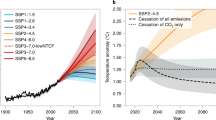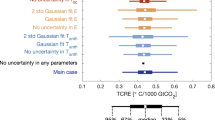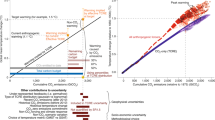Abstract
Global efforts to mitigate climate change are guided by projections of future temperatures1. But the eventual equilibrium global mean temperature associated with a given stabilization level of atmospheric greenhouse gas concentrations remains uncertain1,2,3, complicating the setting of stabilization targets to avoid potentially dangerous levels of global warming4,5,6,7,8. Similar problems apply to the carbon cycle: observations currently provide only a weak constraint on the response to future emissions9,10,11. Here we use ensemble simulations of simple climate-carbon-cycle models constrained by observations and projections from more comprehensive models to simulate the temperature response to a broad range of carbon dioxide emission pathways. We find that the peak warming caused by a given cumulative carbon dioxide emission is better constrained than the warming response to a stabilization scenario. Furthermore, the relationship between cumulative emissions and peak warming is remarkably insensitive to the emission pathway (timing of emissions or peak emission rate). Hence policy targets based on limiting cumulative emissions of carbon dioxide are likely to be more robust to scientific uncertainty than emission-rate or concentration targets. Total anthropogenic emissions of one trillion tonnes of carbon (3.67 trillion tonnes of CO2), about half of which has already been emitted since industrialization began, results in a most likely peak carbon-dioxide-induced warming of 2 °C above pre-industrial temperatures, with a 5–95% confidence interval of 1.3–3.9 °C.
This is a preview of subscription content, access via your institution
Access options
Subscribe to this journal
Receive 51 print issues and online access
$199.00 per year
only $3.90 per issue
Buy this article
- Purchase on SpringerLink
- Instant access to full article PDF
Prices may be subject to local taxes which are calculated during checkout



Similar content being viewed by others
References
Meehl, G. A. et al. in Climate Change 2007: The Physical Science Basis (eds Solomon, S. et al.) Ch. 10 (Cambridge Univ. Press, 2007)
Knutti, R. & Hegerl, G. C. The equilibrium sensitivity of the Earth’s temperature to radiation changes. Nature Geosci. 1, 735–743 (2008)
Hansen, J. E. et al. Target atmospheric CO2: Where should humanity aim? Open Atmos. Sci. J. 2, 217–231 (2009)
Solomon, S., Plattner, G.-K., Knutti, R. & Friedlingstein, P. Irreversible climate change due to carbon dioxide emissions. Proc. Natl Acad. Sci. USA 10.1073/pnas.0812721106 (2009)
Wigley, T. M. L., Richels, R. & Edmonds, J. A. Economic and environmental choices in the stabilisation of atmospheric CO2 concentrations. Nature 379, 240–243 (1996)
Schneider, S. H. & Mastrandrea, M. D. Probabilistic assessment of dangerous climate and emissions pathways. Proc. Natl Acad. Sci. USA 102, 15728–15735 (2005)
Meinshausen, M. in Avoiding Dangerous Climate Change (eds Schellnhuber, H. J. et al.) Ch. 28 (Cambridge Univ. Press, 2006)
Harvey, L. D. D. Allowable CO2 concentrations under the United Nations Framework Convention on Climate Change as a function of the climate sensitivity probability distribution function. Environ. Res. Lett. 2, 014001 (2007)
Friedlingstein, P. et al. How positive is the feedback between climate change and the carbon cycle? Tellus 55B, 692–700 (2003)
Jones, C. D., Cox, P. M. & Huntingford, C. Climate-carbon cycle feedbacks under stabilization. Tellus 58B, 603–613 (2006)
Matthews, H. D. Effect of CO2 fertilization uncertainty on future climate change in a coupled climate-carbon model. Glob. Change Biol. 13, 1068–1078 (2007)
Den Elzen, M. G. J. & Van Vuuren, D. P. Peaking profiles for achieving long-term temperature targets with more likelihood at lower costs. Proc. Natl Acad. Sci. USA 104, 17931–17936 (2007)
Huntingford, C. & Lowe, J. Overshoot scenarios and climate change. Science 316, 829 (2007)
Frame, D. J. et al. Alternatives to stabilization scenarios. Geophys. Res. Lett. 33 10.1029/2006GL025801 (2006)
Huntingford, C. et al. Contributions of thermal and carbon cycle uncertainty to future climate projection spread. Tellus 61B, 355–360 (2009)
Friedlingstein, P. et al. Climate–carbon cycle feedback analysis, results from the C4MIP model intercomparison. J. Clim. 19, 3337–3353 (2006)
Schneider, S. H. Abrupt non-linear climate change, irreversibility and surprise. Glob. Environ. Change 14, 245–258 (2004)
Lowe, J. A. et al. How difficult is it to recover from dangerous levels of global warming? Environ. Res. Lett. 4, 014012 (2009)
Pawitan, Y. In all Likelihood: Statistical Modeling and Inference Using Likelihood Ch. 2.6 and 3.4 (Oxford Univ. Press, 2001)
Meinshausen, M. et al. Greenhouse-gas emission targets for limiting global warming to 2 °C. Nature 10.1038/nature08017 (this issue)
Stott, P. A. et al. Observational constraints on past attributable warming and predictions of future global warming. J. Clim. 19, 3055–3069 (2006)
Broecker, W. S. CO2 arithmetic. Science 315, 1371 (2007)
Wigley, T. M. L. CO2 emissions: a piece of the pie. Science 316, 829–830 (2007)
Matthews, H. D. & Caldeira, K. Stabilizing climate requires near-zero emissions. Geophys. Res. Lett. 35, L04705 (2009)
Matthews, H. D. et al. The proportionality of global warming to cumulative carbon emissions. Nature 10.1038/nature08047 (in the press)
Shine, K. P. et al. Alternatives to the global warming potential for comparing climate impacts of emissions of greenhouse gases. Clim. Change 68, 281–302 (2005)
Shine, K. P. et al. Comparing the climate effect of emissions of short- and long-lived climate agents. Phil. Trans. R. Soc. A 365, 1903–1914 (2007)
Friedlingstein, P. & Solomon, S. Contributions of past and present human generations to committed warming caused by carbon dioxide. Proc. Natl Acad. Sci. USA 102, 10832–10836 (2005)
Plattner, G.-K. et al. Long-term climate commitments projected with climate-carbon cycle models. J. Clim. 21, 2721–2751 (2008)
Frame, D. J. et al. Constraining climate forecasts: the role of prior assumptions. Geophys. Res. Lett. 32 10.1029/2004GL022241 (2005)
Keeling, C. D. & Whorf, T. P. Atmospheric CO2 records from sites in the SIO air sampling network. In Trends: A Compendium of Data on Global Change (Carbon Dioxide Information Analysis Center, Oak Ridge National Laboratory, US DOE, 2005)
Acknowledgements
We thank N. Gillett, K. Shine and T. Stocker for suggestions, P. Stott for estimates of twentieth-century-attributable warming, J. Welby for help calibrating the simple climate model. P. Friedlingstein and the C4MIP modelling community for model output and I. Tracey for help with the manuscript. M.R.A. and D.J.F. acknowledge support from NERC and the FP6 ENSEMBLES project. M.R.A. received additional support from the International Detection and Attribution Working Group (IDAG), supported by the DOE Office of Science, Office of Biological and Environmental Research and NOAA Climate Program Office, and from the British Council. C.H. acknowledges the CEH Science Budget Fund. C.D.J. and J.A.L. were supported by the Joint DECC, Defra and MoD Integrated Climate Programme (DECC/Defra GA01101; MoD CBC/2B/0417_Annex C5).
Author Contributions M.R.A. and D.J.F. designed, tested and ran the simple climate model. C.H., C.D.J. and J.A.L. developed and tuned HadSCCCM1 and C.H. and J.A.L. ran the simulations; M.M. ran the MAGICC model contributing to Fig. 3 and N.M. advised on statistical analysis. All authors contributed to writing the paper.
Author information
Authors and Affiliations
Corresponding author
Supplementary information
Supplementary Information
This file contains Supplementary Data, Supplementary References, a Supplementary Table and Supplementary Figures S1-S4 (PDF 4043 kb)
Rights and permissions
About this article
Cite this article
Allen, M., Frame, D., Huntingford, C. et al. Warming caused by cumulative carbon emissions towards the trillionth tonne. Nature 458, 1163–1166 (2009). https://doi.org/10.1038/nature08019
Received:
Accepted:
Issue Date:
DOI: https://doi.org/10.1038/nature08019



